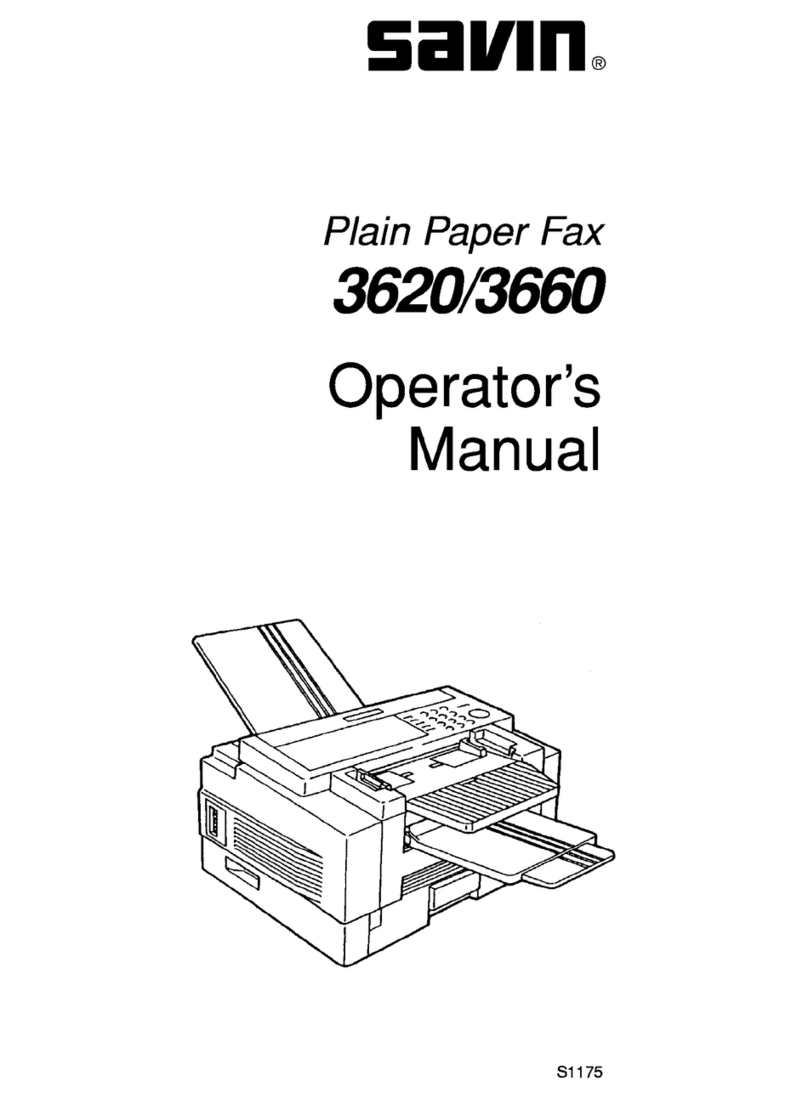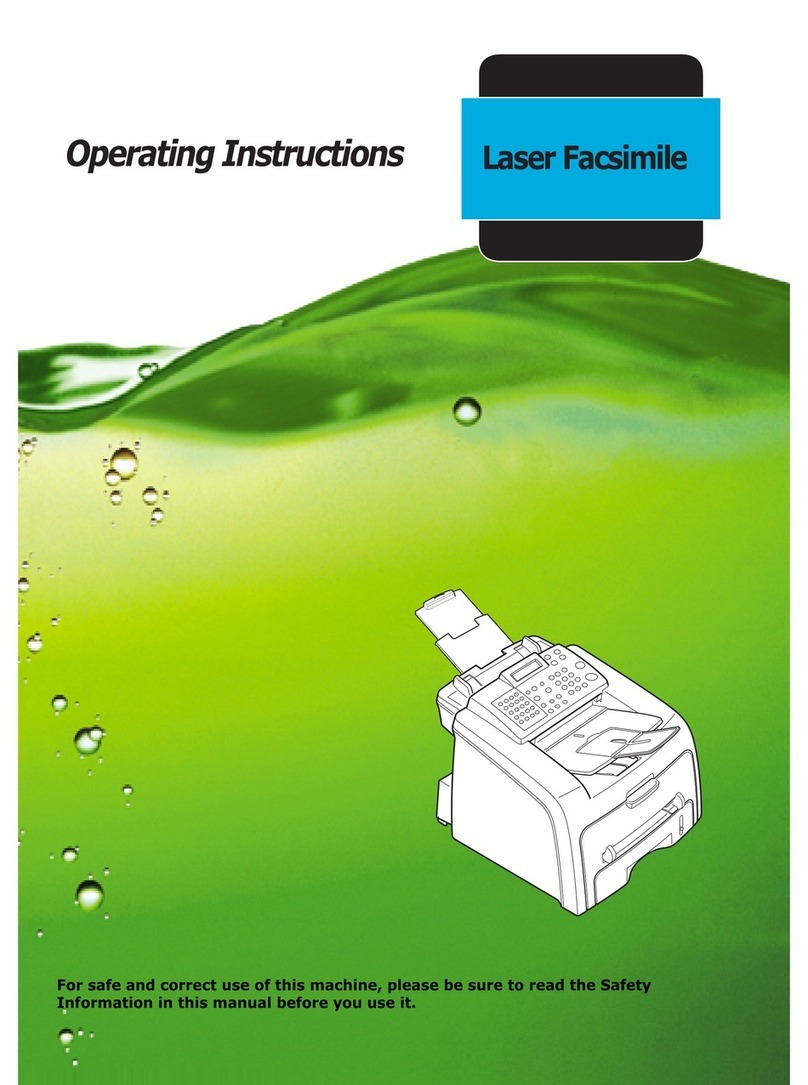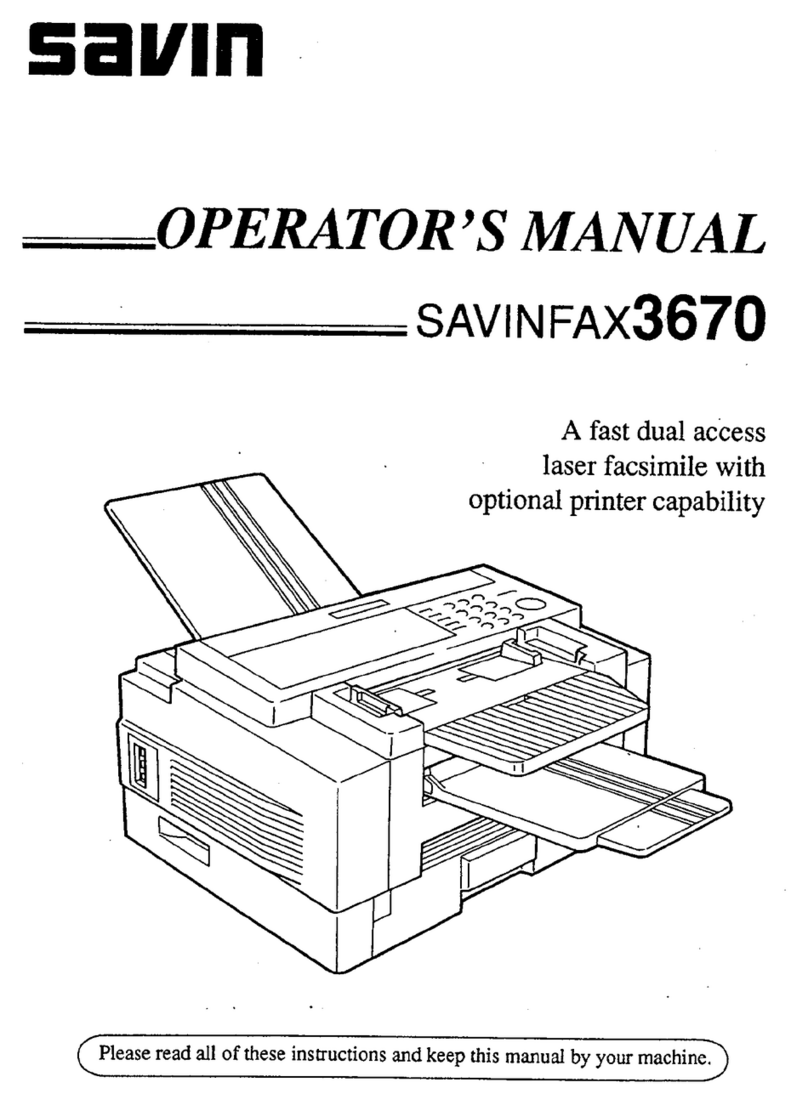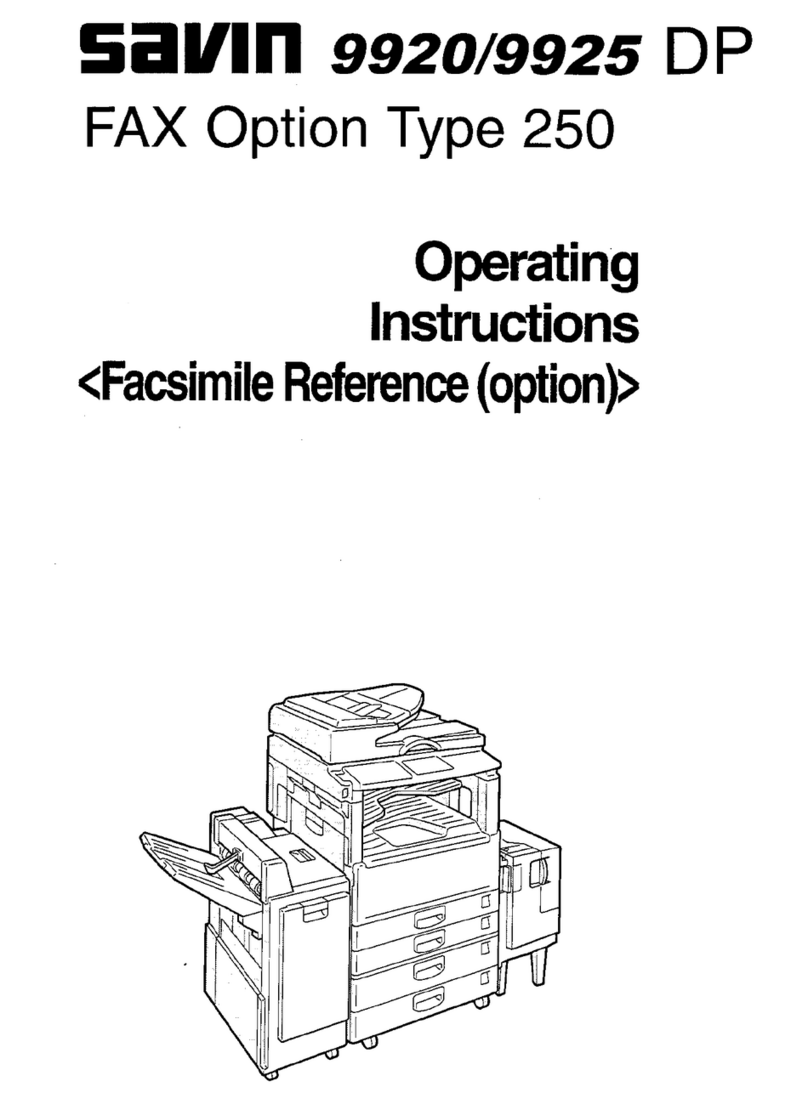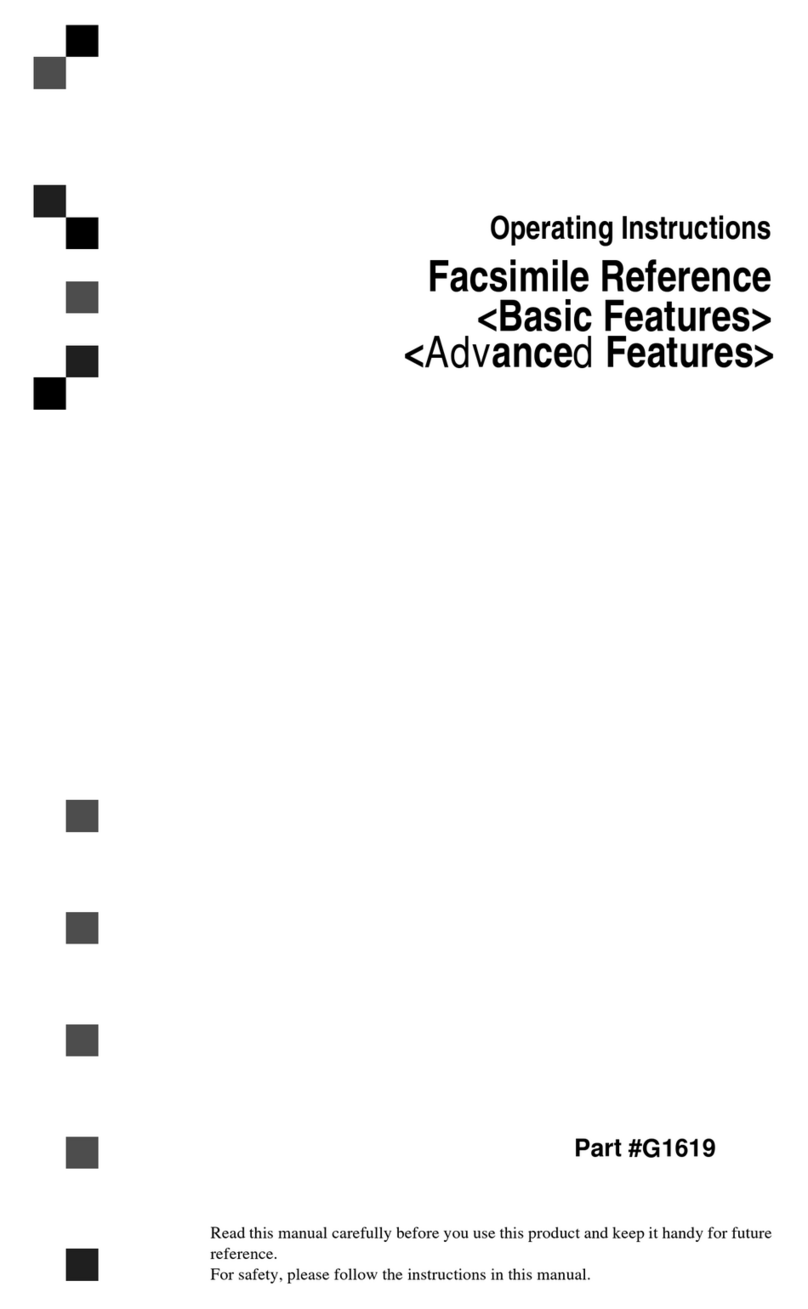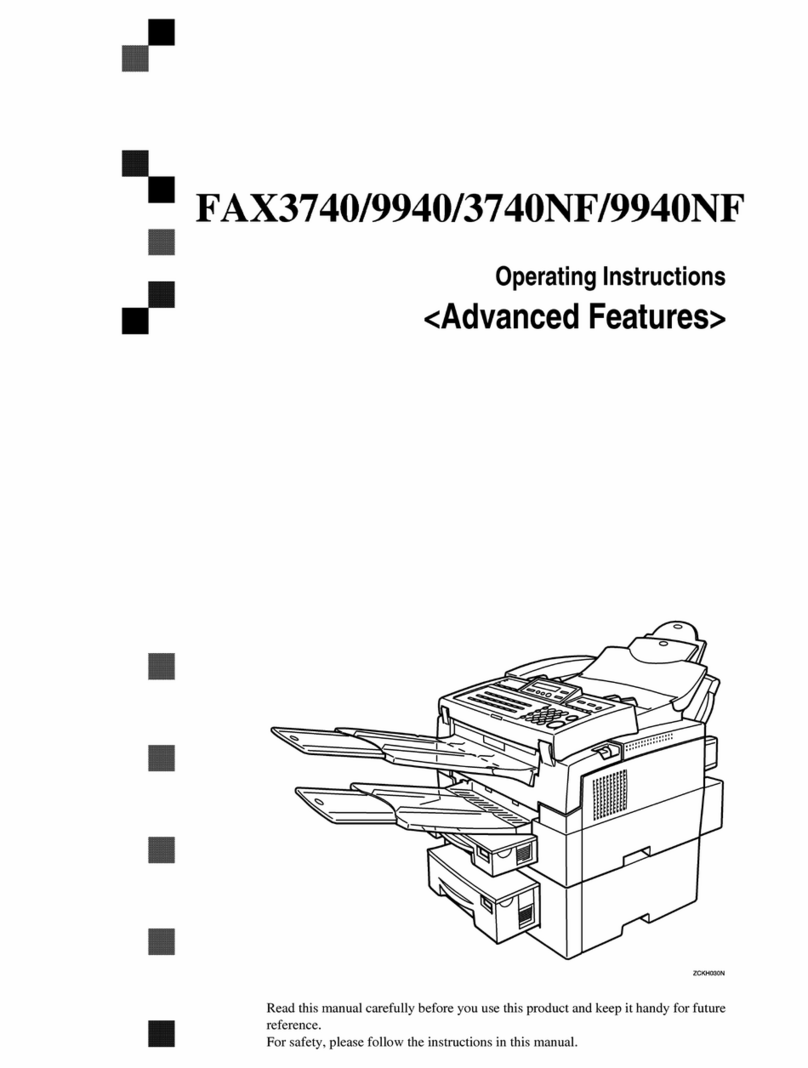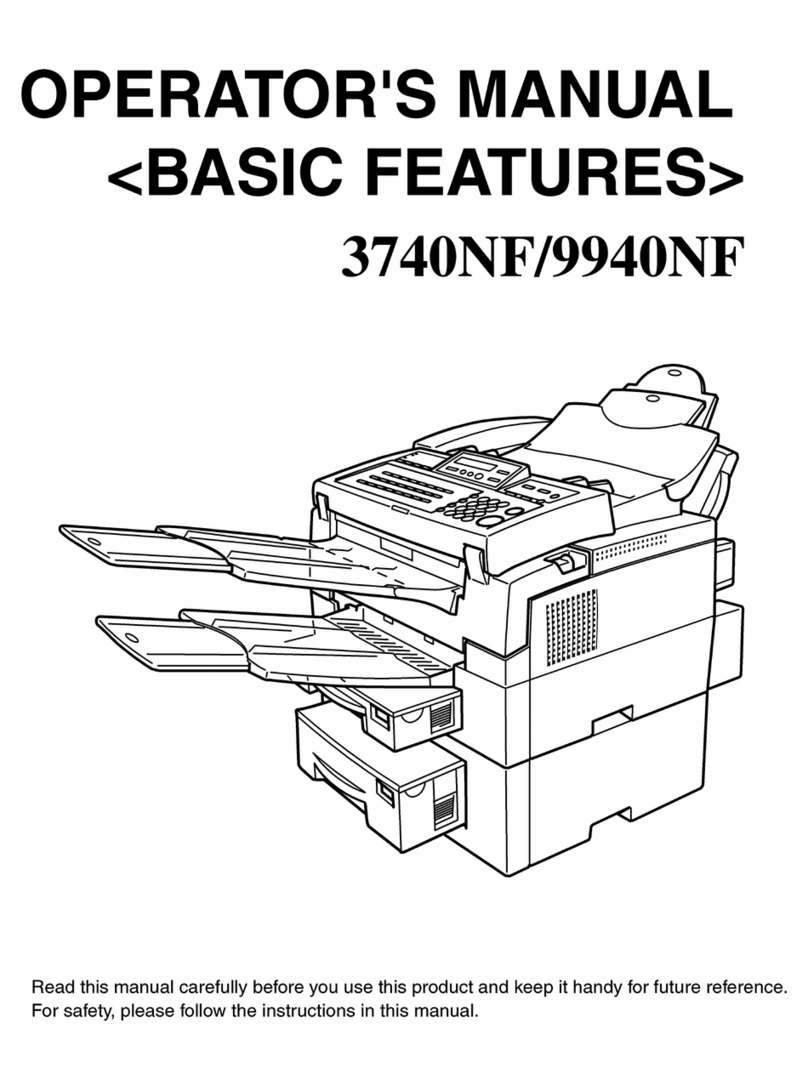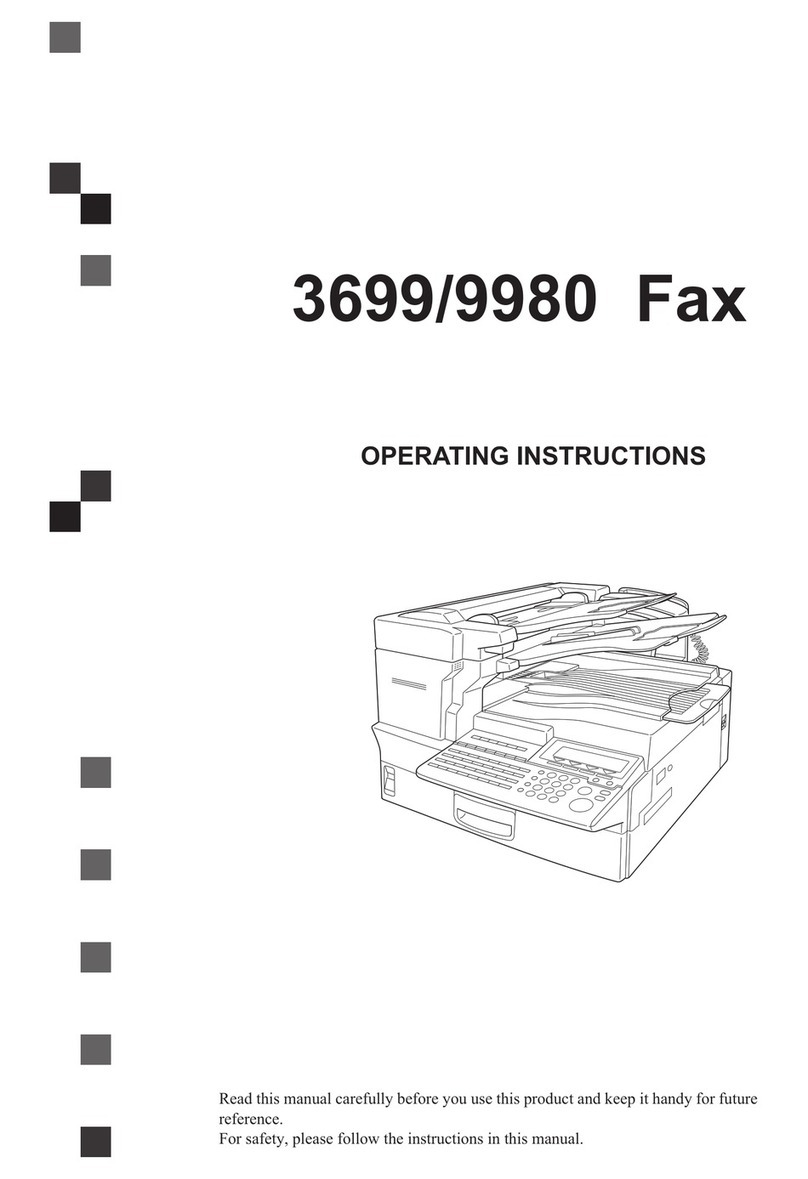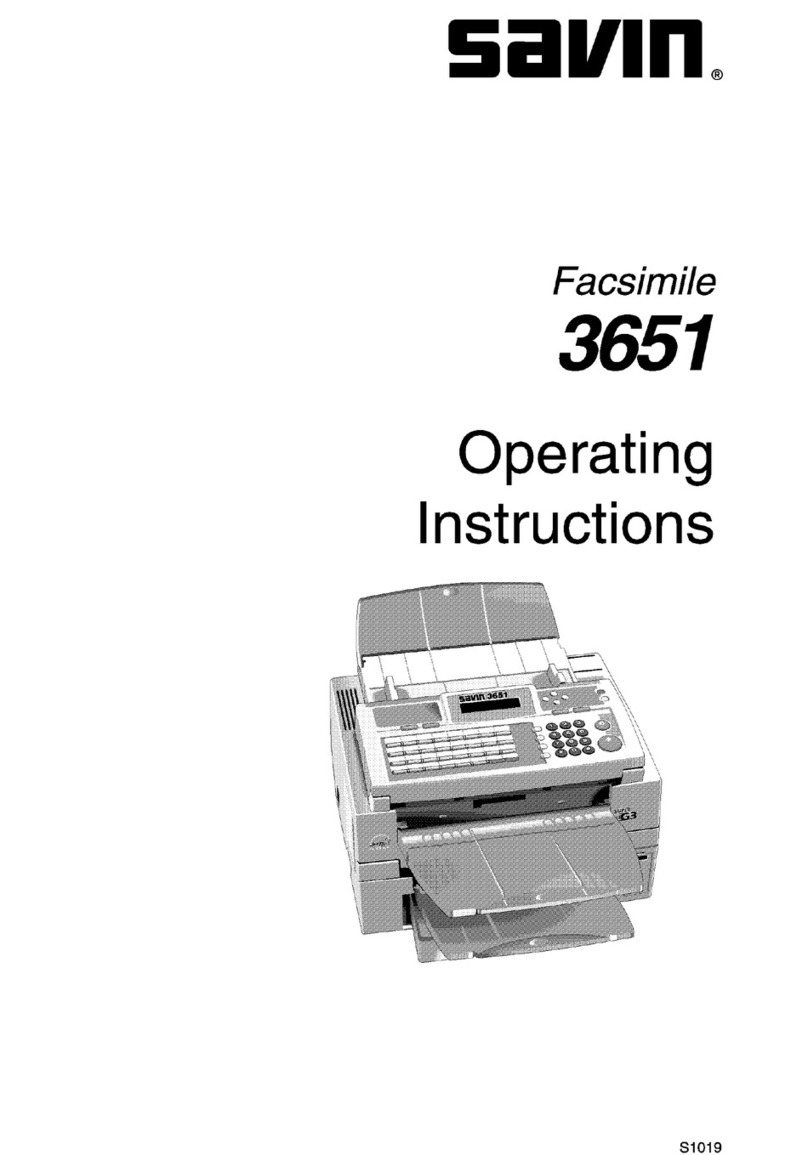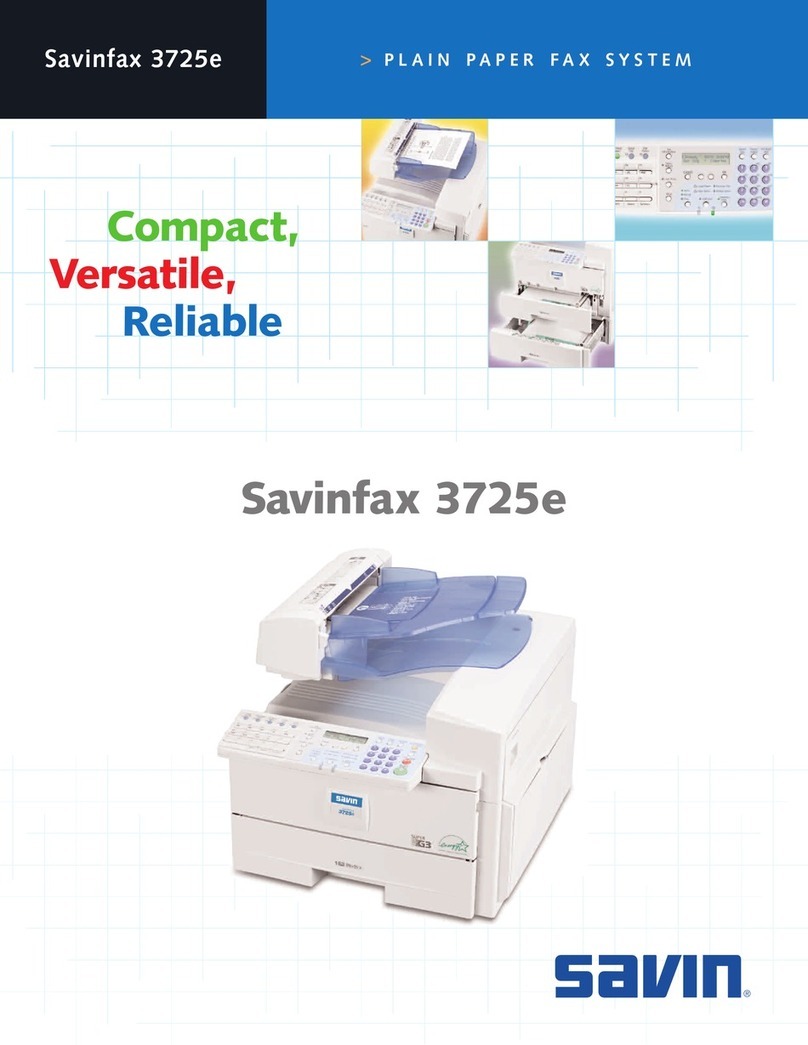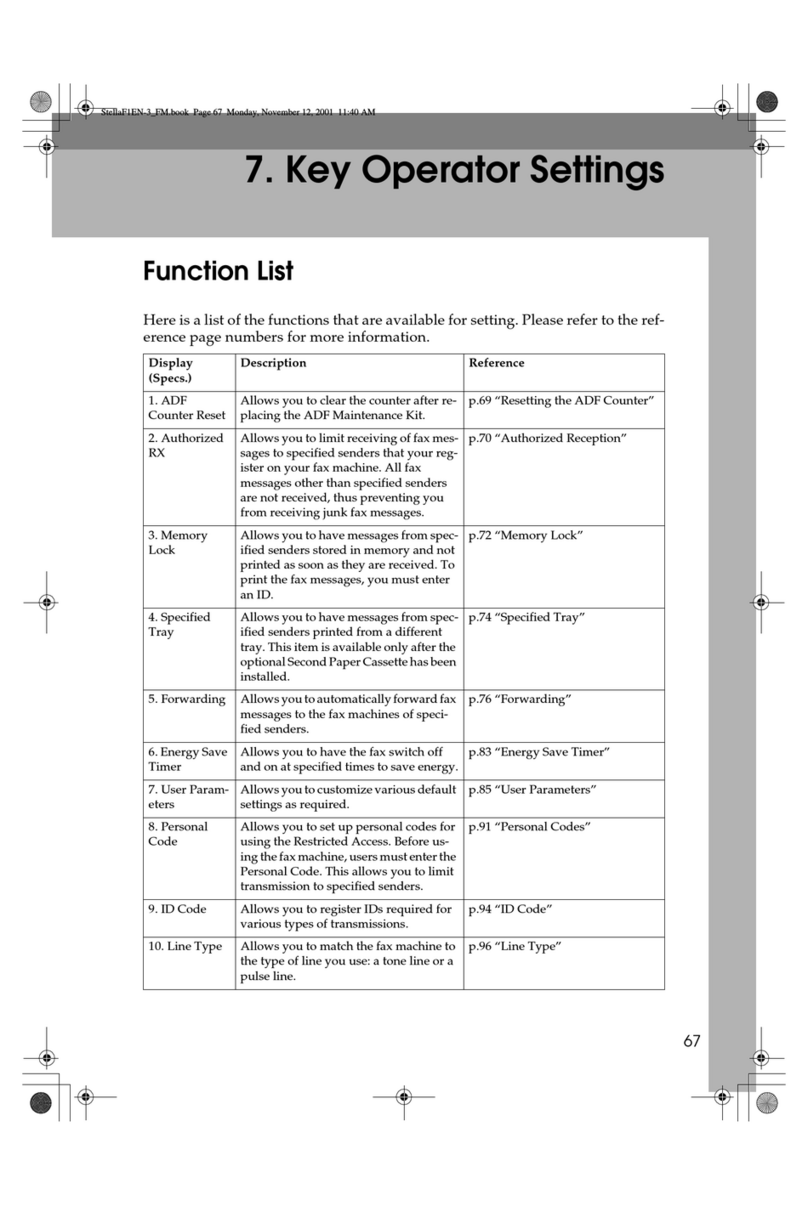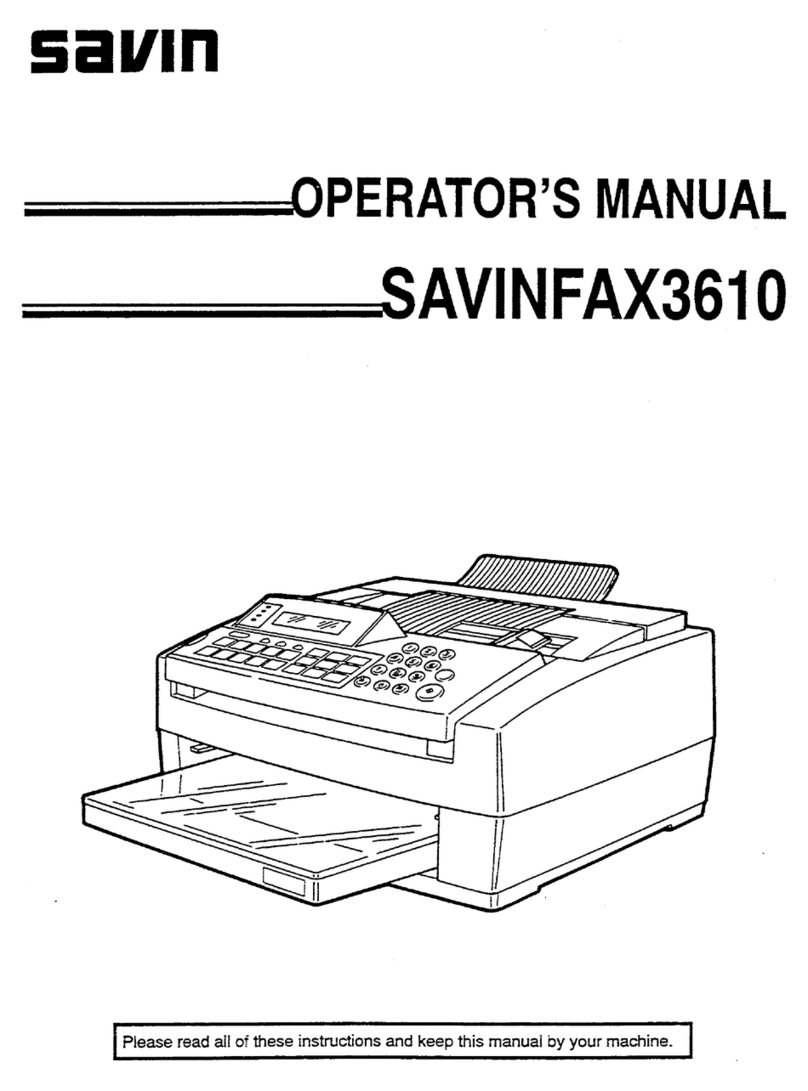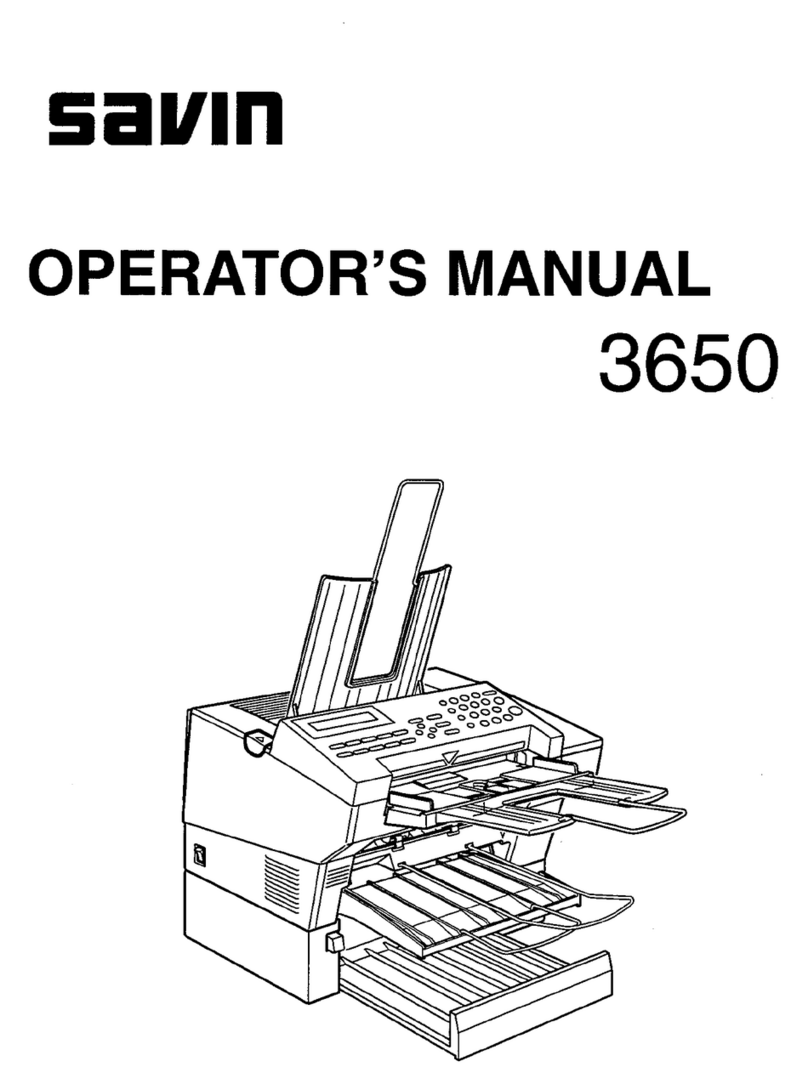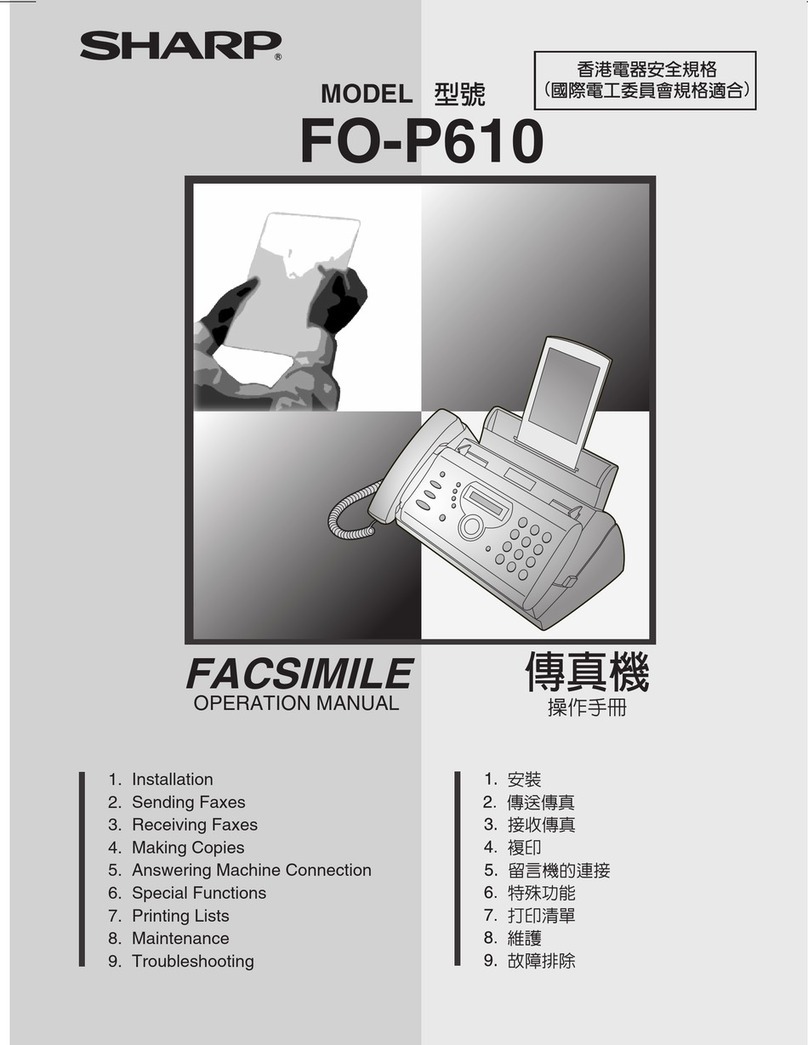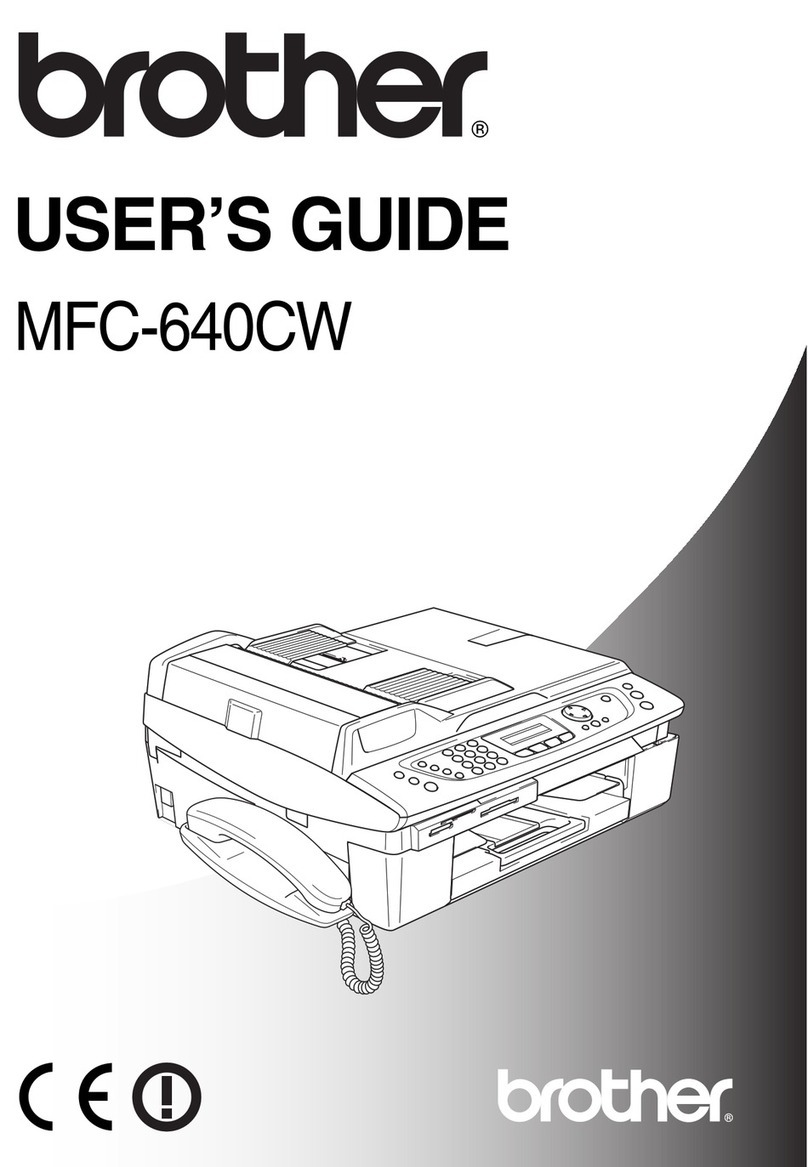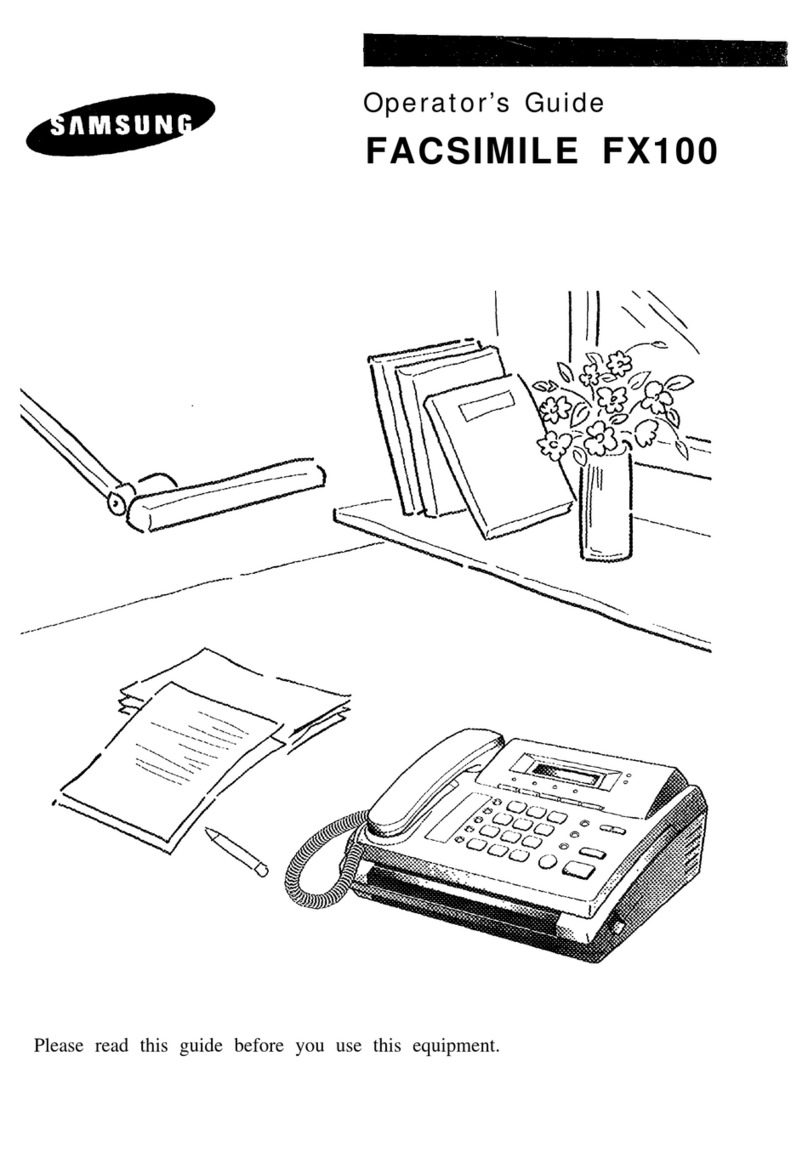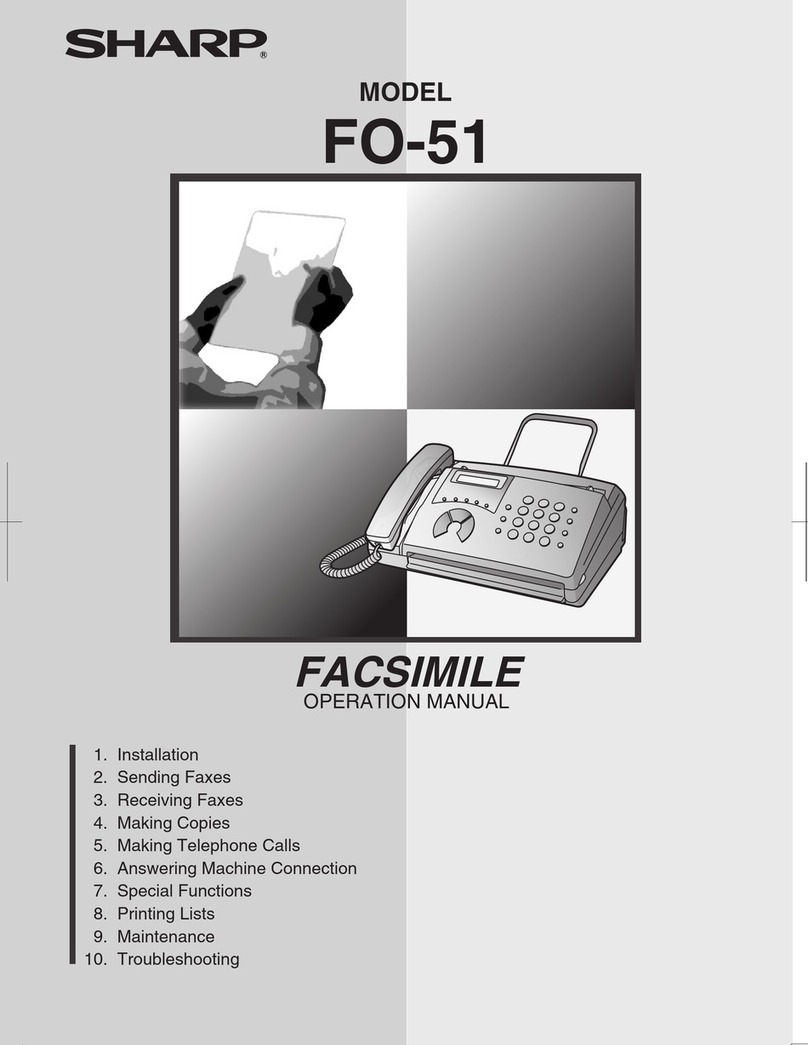
I. Set Date/Time
To set the internal clock to the current date and time,
proceed as follows:
1. Press: [User Tools] key.
2. Press: or until display reads:
3. Press: OK.
4. Press: or until display reads:
5. Press: OK.
6. Press: or until display reads:
7. Press: OK. Display reads:
8. Enter: Year (via numeric keypad), e.g., 02.
9. Press: OK.
10. Press: or to select the correct
month. Display reads, for
example:
11. Press: OK. Display reads:
12. Enter: Date (1 to 31 via numeric keypad), e.g., 15.
13. Press: OK.
14. Press: or to select “AM” or “PM”.
Display reads, for example:
15. Press: OK. Display reads:
16. Enter: Time (via numeric keypad). Note: Enter the current hour
setting (1 to 12), and then use the numeric keypad to enter a
2-digit number for the current minute setting (00 to 59). Press
or to toggle between hours and minutes.
17. Press: OK.
18. Press: [User Tools] key to return to standby.
II. Program Initial Settings
The initial settings — Own Name/Fax Header and Own Fax
Number — will be used to identify your fax unit on reports and
when communicating to other remote fax machines. To program
this information, proceed as follows:
Own Name/Fax Header
1. Press: [User Tools] key.
2. Press: or until display reads:
3. Press: OK.
4. Press: or until display reads:
5. Press: OK.
6. Press: or until display reads:
7. Press: OK. Display should read:
8. Press: OK. Display reads:
9. Enter:Own Name, e.g., your company name, via the Quick
Dial keys which double as alphanumeric and special symbol
keys. For letters, press Quick Dial 01 – 09 or 16 – 24. For
special symbols, press [Symbols]. Press or to scroll through
symbols and press OK to enter. For numbers, press numeric
keypad. To erase characters, press [Clear/Stop]. Display reads,
for example:
10. Press: OK.
11. Press: or until display reads:
Note: Select Fax Header 1 and
Fax Header 2 by pressing or .
▼
▼
▼
▼
▼
▼
▼
▼
▼
▼
▼
▼
▼
▼
▼
▼
▼
▼
▼
▼
▼
▼
▼
▼
X. Program User Function Key
XI. Delete User Function Key
XII. Program Address Template
XIII. Send a Fax
XIV. Send Later
V. Scan-to-Email & Internet Fax
A. Scan-to-Email (Color)
B. Scan-to-Email (B&W)
C. Send an Internet Fax
D. Send an IP-Fax
XVI. Clear a Memory File
I. Set Date/Time
II. Program Initial Settings (Own Name/Fax Header/
Own Fax Number)
III. Program Quick Dial Key with Fax Number/
E-mail Address
IV. Program Quick Dial Key with IP Address
V. Delete Quick Dial
VI. Program Speed Dial Number
VII. Delete Speed Dial Number
VIII. Program Group Dial
IX. Delete Group Dial
User Tools:
2. Fax Features
Fax Features:
3. Setup
Setup:
3. Date/Time
Year: Keypad/OK
[20_ _ ]
Day: Keypad/OK
[ _ _ ]
Own Name: [ABC] /OK
[ ❚❚❚❚❚❚❚❚❚❚❚❚❚❚❚❚]
Own Name: [ABC] /OK
MAIN OFFICE
Time: Keypad/OK
[9:52]
Month: /OK
[August]
▲
▲
AM/PM: /OK
[AM] PM
▲
▲
▲
▲
Setup:
5. Fax Information
▲
▲
Fax Information:
1. Own Name
▲
▲
Fax Information:
2. Fax Header 1
▲
▲
User Tools:
2. Fax Features
▲
▲
Fax Features:
3. Setup
▲
▲
▲
▲
▲
▲
Using a Template:
1. Press: Scan to E-mail or
Internet Fax key (refer to
applicable procedures).
2. Enter the e-mail address prefix,
e.g., jsmith. Display reads:
3. Press: ✯(Quick Dial key).
Display reads:
4. Press: or to select desired template (suffix).
5. Press: OK. Display reads,
for example:
6. Continue with desired procedure.
XIII. Send a Fax
Manual Dial:
1. Place document face up in ADF*.
2. Enter: Fax number (via the numeric keypad).
3. Press: Start.
Quick Dial:
1. Place document face up in ADF*.
2. Press: Quick Dial key (01-90).
3. Press: Start.
Speed Dial:
1. Place document face up in ADF*.
2. Press: Key labeled Speed Dial.
3. Enter: Speed Dial number (001-199).
4. Press: Start.
*Adjust contrast and resolution, if necessary.
XIV. Send Later
To program the unit to send a document after hours, when phone
rates may be lower, proceed as follows:
1. Place document face-up in ADF and select resolution,
if required.
2. Press: [Trans. Option] key.
3. Press: OK. Display should read:
4. Press: or to select “On.”
5. Press: OK. Display reads:
6. Press: OK.
7. Press: or to select “AM” or
“PM.”
8. Press: OK.
9. Enter: Time that you wish to send
the fax (via numeric keypad).
Enter the hour setting (1 to 12).
Enter two-digit number for the minute setting (00 to 59).
Note: If you make a mistake, press [Clear/Stop] and try again.
10. Press: OK and the specified time is set.
11. Enter: Destination(s), i.e., enter number manually, via Quick
Dial key or Speed Dial number. Display reads, for example:
12. If you wish to specify another destination, press OK and repeat
step 11. Otherwise, continue.
13. Press: START key. The document is scanned into memory and
transmitted at the designated time.
XV. Scan to E-mail & Internet Fax
The following section describes how to perform Scan-to-Email
and Internet Fax functions using the network fax functions. The
method you choose depends upon your application requirements.
Please review the comparison chart below to help guide you.
For example, if you wish to send a document…
■in color (recipient views PDF or JPEG attachment via computer),
proceed to A. Scan-to-Email (Color).
■in black & white (recipient views PDF attachment via computer)
proceed to B. Scan-to-Email (B&W).
■to another Internet Fax machine (received attachment prints),
proceed to C. Send an Internet Fax.
■to another IP Fax machine (document prints), proceed to D.
Send an IP-Fax.
A. Scan-to-Email (Color)
1. Place document face up on ADF.
2. Select Color Scan mode
(indicator must be lit).
Display reads:
Note: Default file format is PDF.
To select JPEG, press [F9] JPEG key.
3. Select original size by pressing or , if necessary.
4. Press: OK. Adjust resolution settings, if necessary.
5. Press: Quick Dial key or enter Speed Dial number containing
the programmed e-mail address. The name or e-mail address
of the destination appears. Go to step 9.
Note: Autodial keys should be pre-programmed by Scan to
Email key, not by Internet Fax key. If the e-mail address is not
preprogrammed, go to the next step.
6. Press: Scan to E-mail [F10] key.
Display reads:
7. Enter: E-mail address manually.
Note: Enter digits via numeric keypad, characters and symbols
[e.g., @] using QWERTY Quick Dial keypad. (See section XII.
Program Address Template for programming/using e-mail
address templates.)
▼
▼
▼
▼
▼
▼
▼
▼
Scan-to-Email Internet Fax (T.37) IP Fax (T.38)
File Color: JPEG or PDF Monochrome: TIFF-F Not Applicable
Attachment Monochrome: PDF (end-to-end
Format or TIFF-F real-time
communication)
Original Size 11" x 17" 8.5" x 14" 8.5" x 14"
(Max.)
Scan 600 x 600 dpi 200 x 200 dpi 600 x 600 dpi
Resolution
(Max.)
Comments ■Recommended for ■Recommended ■IP-Fax enables
sending to an e-mail when sending to you to send fax
account, i.e., another Internet Fax messages via
recipient views machine, i.e., networks that use
document on PC. remote IFax prints TCP/IP, e.g., LAN,
document. WAN or Intranet.
■To view PDF ■When received to ■Requires IP-Fax
attachments, the e-mail, the user machines on both
recipient must have must have a TIFF-F send and receive
Adobe Acrobat viewer to open/view side.
Reader. the attachment.
Note: The unit must be connected to a LAN (Local Area Network) and properly
configured in order to use Scan-to-Email and Internet Fax functions.
Select Template with
key
▲
▲
Scanner: [abc] Address
❚ ❚ ❚ ❚ ❚ ❚ ❚ ❚ ❚ ❚ ❚ ❚ ❚ ❚ ❚ ❚ ❚
Scanner: [abc] Press OK
jsmith ❚ ❚ ❚ ❚ ❚ ❚ ❚ ❚ ❚ ❚
Scanner: [abc] Press OK
Trans. Option:
1. Send Later
▲
▲
Send Later: /OK
On [Off]
▲
▲
Send Later: /OK
Economy Tx [Option]
▲
▲
Send Later: /OK
Time AM [PM]
▲
▲
Send Later: Press OK
Time [11:30] PM
Dest. 1 OK to Add
2225451234 ❚ ❚ ❚ ❚ ❚ ❚ ❚ ❚ ❚
Scanner: [abc] Address
❚ ❚ ❚ ❚ ❚ ❚ ❚ ❚ ❚ ❚ ❚ ❚ ❚ ❚ ❚ ❚ ❚
Color Orig. Size /OK
[8
1⁄2
x 11]
▲
▲
5
8. Press: Start.
Notes:
■You cannot specify an Internet Fax machine as a destination.
■Color Scanning is not available for Backup Transmission.
■The Fax Header (TTI) is not added to the transmitted data.
■The setting for maximum file size is invalid for Color
Scanning.
■You can store the Color Scan mode and resolution into a
Keystroke Program if you regularly send color documents to
particular destinations, with a specific resolution.
■E-mail delivery may be delayed due to network congestion.
B. Scan-to-Email (B & W)
1. Select Memory Trans. mode (indicator is lit).
2. Place document face up on ADF. Adjust resolution settings,
if necessary.
3. Press: Quick Dial key, Group Dial key or enter Speed Dial
number containing programmed e-mail address(es). The name
or e-mail address of the destination appears. Go to step 6.
Note: Autodial keys should be pre-programmed by Scan to
Email key, not by Internet Fax key. If the e-mail address is not
preprogrammed, go to the next step.
4. Press: Scan to E-mail [F10] key.
5. Enter: E-mail address manually.
Note: Enter digits via numeric keypad, characters and symbols
[e.g., @] using QWERTY Quick Dial keypad. (See section XII.
Program Address Template for programming/using e-mail
address templates.)
6. To specify another destination, press OK. Repeat step 3.
7. When finished, press Start.
Notes:
■The attachment to e-mail is in PDF or TIFF-F format,
whichever has been specified in the user parameters.
TIFF-F and PDF attachments cannot be received to an
Internet Fax machine, only to an e-mail inbox.
■E-mail delivery may be delayed due to network congestion.
C. Send an Internet Fax
1. Select Memory Trans. mode (indicator is lit).
2. Place document face up on ADF. Adjust resolution settings,
if necessary.
3. Press: Quick Dial key, Group Dial key or enter Speed Dial
number containing programmed e-mail address(es). The name
or e-mail address of the destination appears. Go to step 6.
Note: Autodial keys should be pre-programmed by Internet
Fax key. If the e-mail address is not pre-programmed, go to
the next step.
4. Press: Internet Fax [F5].
5. Enter: E-mail address manually.
Note: Enter digits via numeric keypad, characters and symbols
[e.g., @] using QWERTY Quick Dial keypad. (See section XII.
Program Address Template for programming/using e-mail
address templates.)
6. To specify another destination, press OK. Repeat step 3.
7. When finished, press Start.
Notes:
■Internet faxing does not allow for Immediate Transmission.
■Accepts 8.5” x 11” originals. Legal-size (8.5” x 14”)
documents can be sent without reduction.
■Since NIC FAX sends data as an attached TIFF-F image (black
& white), the recipient must have a TIFF viewer application in
order to view the document on a PC.
■E-mail delivery may be delayed due to network congestion.
■Though color documents can be scanned, the Internet Fax
function does not support transmission in color (see previous
section for scanning in color).
D. Send an IP-Fax
1. Place document face up on ADF. Adjust resolution settings,
if necessary.
2. Press: Quick Dial key, Group Dial key or enter Speed Dial
number containing programmed IP address(es). The name or
e-mail address of the destination appears. Go to step 7.
Note: Autodial keys should be pre-programmed by Internet
Fax key. If the e-mail address is not preprogrammed, go to the
next step.
3. Press: Internet Fax [F5].
Display reads:
4. Enter: IP address or Host Name.
Note: Enter digits via the numeric keypad; the period is on the
[@._] key (next to “Symbols” Quick Dial key).
Display reads, for example:
5. Press: OK. Display reads:
6. Press: OK. Display reads:
7. To specify another destination, press OK. Repeat step 2.
8. When finished, press Start.
XVI. Clear Files in Memory
1. Press: [Job Information] key.
Display reads:
2. Press: OK. Display reads:
3. Press: or to display the file you
wish to cancel. Display reads,
for example:
Note: If you cannot find the file you wish
to cancel, the document has already been sent.
4. Press: OK. Display reads:
5. Press: OK to confirm. “Trans. Cancelled/File Deleted” is
displayed and machine returns to standby.
▼
▼
Address
2. IP-Fax Address
▲
▲
Job Information:
1. Cancel TX/RX
▲
▲
Dest1 OK to Add
<...>192.168.1.10
File No. to Cancel
No. ❚ ❚ ❚ (Browse )
▲
▲
Cancel File? /OK
No. 099 9738821212
▲
▲
Cancel? /OK
[Yes] No
▲
▲
Scanner: [abc] Address
❚ ❚ ❚ ❚ ❚ ❚ ❚ ❚ ❚ ❚ ❚ ❚ ❚ ❚ ❚ ❚ ❚
Address: [abc] /OK
❚ ❚ ❚ ❚ ❚ ❚ ❚ ❚ ❚ ❚ ❚ ❚ ❚ ❚ ❚ ❚ ❚
Address: [abc] /OK
❚ ❚ ❚ ❚ ❚ ❚ ❚ ❚ ❚ ❚ ❚ ❚ ❚ ❚ ❚ ❚ ❚
Address: [abc] /OK
192.168.1.10 ❚ ❚ ❚ ❚ ❚ ❚ ❚ ❚
6
SAVIN 3760/3760nf
Quick Reference Guide
93199D_b 2/18/05 9:46 AM Page 1

